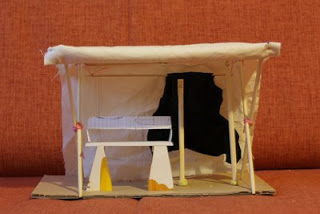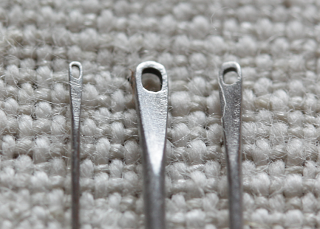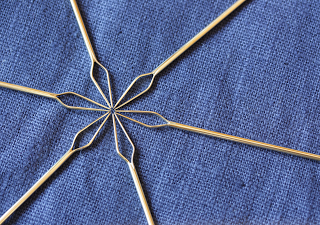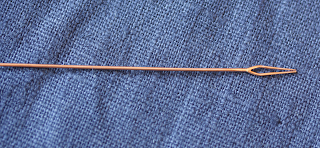Though really beautiful, our current tent is not very well suited to show-and-tell or sale of goods on medieval markets or events. So I'm saddled with the need for an additional market stall to take with me when I'm on my own for a market. And that, as usual, brings all sorts of problems.
First of all, the medieval markets we have here today are mostly show-events for the enjoyment of visitors, both contemporary and LH*-visitors, while a more comparable event to the real medieval markets/fairs would probably be a modern (business) fair or one of the old-fashioned "Jahrmärkte" where there are mostly stalls selling things and only some muncheonettes and very, very few amusement rides (like a carousel for children, and that's it). So for the medieval market, there is a lot of logistic but very, very varying sales figures for the sellers (while stuff to munch on is always bought).
Today's medieval markets are roughly split into two sorts of events: Those for the modern visitors and those for the LH folks. Both types are, of course, frequented by both groups, but usually an event has its focus on one of the groups. Markets for modern visitors will either offer information (or should I write infotainment, since it is usually perceived as entertaining) and a few goods for sale (that might or might not be on sale for actually selling a lot, but also for displaying things on offer in the middle ages). That is a good visitor-oriented market. If it's a bad one, it looks a bit like Disneyland trying to go into the past: Usually some non-medieval music somewhere, foodbooths liberally using potatoes and other modern food, and the stalls are obviously geared towards selling Hollywood-medievalistic-seeming trinkets to unsuspecting visitors. Sprinkle this with a generous serving of bad clothes, clichés and misinformation, and you are done. These can be a really bad experience.**
Markets geared towards LH folks ("Lagermärkte" in German) usually have lots of non-selling LH people there for their enjoyment and a large market area with booths and stalls selling mostly things needed (or wanted) for LH purposes. Those events are where you can buy naturally dyed cloth and yarn, hand-made copper-alloy pins and needles, buckles and brooches, boxes from wood, plates, beakers, glasswares, leatherwares, you name it. Target buyers for the stalls are mostly LH participants and visitors. In case you ever wondered, this is where we do lots of our shopping, planning, and drooling over things too expensive, not in our time or not in our status range, but still so beautiful they are worth sighing over.
So the LH markets are more like a modern business fair in some respect and as such closer to the real medieval market (probably minus the hundreds of large tents on the camp areas). And like the sellers going to the markets a few hundred years ago, today's sellers are faced with rather large logistics problems.
As a seller, you need a place and way to present the goods and some space to sleep. You need to hide your own clothes and paraphernalia somewhere (like a chest or covered basket), you need to bring decoration and, of course, the goods. All that stuff has to fit into a vehicle for transport and you have to be able to set up your tent or stall in an adequate time and preferably without lots of helpers. And for those who like it authentic today, there's not too much documentation.
Since bringing stalls would have been a huge logistic effort in the middle ages, but stalls are regularly seen on pictures, I'm wondering - were those stalls semi-permanent fixtures, set up in spring and taken down after the last market in autumn? Were they stalls of regular market sellers from the region? Did sellers for a larger market with wider catchment area bring their own stalls and booths? Everything - cloth and wood - or just the cloth, cutting the wood parts from nearby? Did they bring cooking gear (I'd doubt it) or did they buy their food? And how did the stalls look like? What worked for what kind of profession or offered goods?
While I'm wondering about that, I'm trying to design a stall that will at least look plausible to the not-too-critical eye. And meets my requirements: Fits in the car (this limits the maximum length of the poles); is made of cloth, wood and leather with little or no metal; can be closed completely for nights and for bad weather; small yet offering enough space to display/sell, show-and-tell and sleep; cloth from linen, tightly woven so no water comes through, and half-bleached for enough light inside the stall; with a crossbeam for hanging garments in the typical medieval way of garment presentation at a tailor shop; and if at all possible, can be set up by me on my own (which also limits total height, since I cannot reach higher than 2,15 m without something to stand on.
So after a lot of planning and great fun while tinkering (and even fun doing the maths required), I present to you: My model of the future market stall. The small chopstick figure beside the table, that's me, and the tall chap (or chop?) is a 2 metre tall visitor (who had to duck a tiny bit for coming in). It doesn't have the side parts, of course, but there's a crossbeam with a dress hanging over it and my future table with a display stand on it and there's even a curtain to close off a little space for sleeping and storing stuff in the back. And all on the rather small footprint of ca. 2,5 on 2,5 metres. I like it!

* Living History, of course. I warned you several times in this blog that I'm lazy, didn't I?
**Unfortunately, it's hard to tell which kind it will be just from reading "Medieval Market There and Then" on a poster. There could be money made with a detector, I guess...












